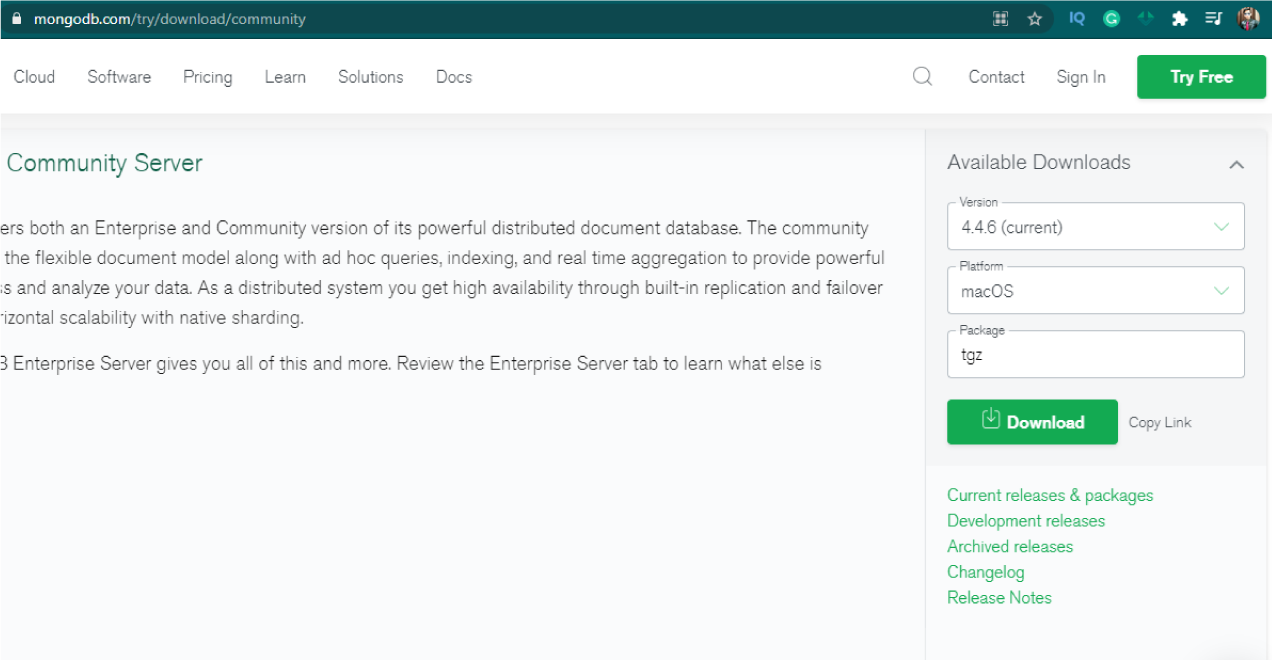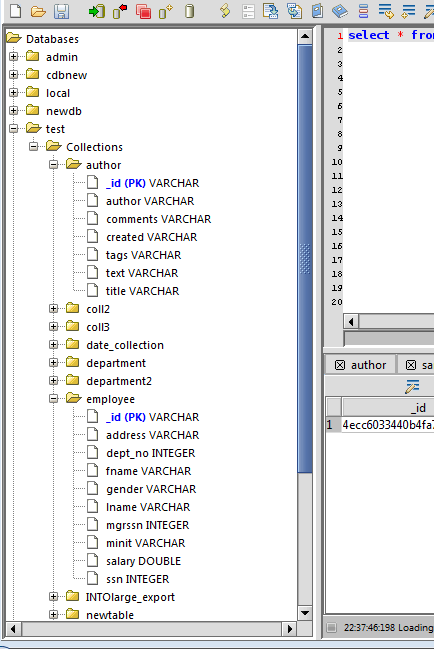Nope you don't pixel67.
Aug 19, 2021 What is Mongomix for Mac. Mongomix is a free MongoDB GUI client. It provides an intuitive interface to view and edit MongoDB collection objects. Key features: Full text search: For browsing tables. For object references editing. Full feature object editing: Point and click. Download Mongodb Macos MongoDB offers both an Enterprise and Community version of its powerful distributed document database. The community version offers the flexible document model along with ad hoc queries, indexing, and real time aggregation to provide powerful ways to access and analyze your data.
First off, when installing MongoDB from Brew, it will install it into: /usr/local/Cellar/mongodb/3.2.7/
The configuration file will be located in: /usr/local/etc/mongod.conf
If you open it up, you'll see that you db directory is specified:
systemLog:
destination: file
path: /usr/local/var/log/mongodb/mongo.log
logAppend: true
storage:
dbPath: /usr/local/var/mongodb
net:
bindIp: 127.0.0.1
Start MongoDB using your configuration file:
$ mongod --config /usr/local/etc/mongod.conf
Open a new terminal tab and connect to MongoDB:
$ mongo
This is a tutorial for setting up MongoDB on MacOS. You might be wondering why there's a need for another setup guide for MongoDB in the first place, since there are a few across the web. I found many tutorials and guides on how to set it up, but found most of them to be unclear and outdated, based on old MongoDB versions. The checklist is not comprehensive, though, as it is used for several tutorials on my website, I keep it updated with the recent versions of MongoDB. If you spot any flaws in this guide, a comment below would be very helpful to keep it up to date for other developers.
Navicat for MongoDB gives you a highly effective GUI interface for MongoDB database management, administration and development. Connect to local/remote MongoDB. However, if you want to check the installation via the system search on Mac, say using phrase such as mongod or mongodb, it will show the physical location of the installed directory and files starting with the searched phrase. If you get hold of this directory, you will see a bin directory, which will have binary files.
Mac OS X How to automatically run elasticsearch on Startup for Mac OS X. If you are like me you want most of the things to be automate like my previous post showing you how to run MongoDB on StartUp for Mac OS X, and this post. There are many MongoDB GUI available for Mac Operating System, the most used GUI I think are MongoDB Compass and RoboMongo. The reason for using MongoDB Compass: Easy implementation of run ad hoc. It is having an inbuilt schema visualization. You can easily work with your geospatial data. You can visualize your data while performing the CRUD.
If you want to run MongoDB on Windows instead, you will find guidance over here: How to setup MongoDB on Windows.
MongoDB Installation on MacOS
I recommend Homebrew for installing and managing applications on MacOS. It is installed using the following command in the MacOS terminal. Open up the terminal and paste the command:
The terminal runs through a series of installation operations, and will probably create folders in your local machine to accommodate Homebrews storage requirements. You can find more detailed instructions here. After it's installed, update the Homebrew dependencies and install MongoDB on the command line:
It will take a few seconds. Once it's done, create a directory so MongoDB can store its data.
Now to make sure this data directory have the right permissions, you'll run this command:
Now our data directory is ready with right permissions. Next run mongo daemon. Which is a service which runs in the background and listens for connections on a given port. Run this command:
Now mongo daemon will be running in the background and can be used by your applications. Next, check your MongoDB version:

Mongodb Install Mac Os


The command line results will show the version you have installed on your local machine. I recommend using the latest version of libraries and software whenever possible to avoid compatibility issues with client-side applications.
Mongodb Client Mac
What’s MongoDB?
Magnifying Glass Icon - MongoDB.
MongoDB is a document database which belongs to a family of databases called NoSQL - not only SQL. In MongoDB, records are documents which behave a lot like JSON objects in JavaScript. Values in documents can be looked up by their field’s key. Documents can have some fields/keys and not others, which makes Mongo extremely flexible.
This is different than SQL databases like MySQL and PostgreSQL, where fields correspond to columns in a table and individual records correspond to rows.
Prerequisites
Mongodb Compass Download Windows 10
- You should have some familiarity with the Mac Terminal application since you’ll need to use it to install and run MongoDB.
- Dependencies. This guide goes over the two main ways to install MongoDB on a Mac. One of the methods requires Homebrew.
- Homebrew. Homebrew is a package manager for the Mac – it makes installing most open source software (like MongoDB) as simple as writing
brew install mongodb. Follow the instructions in the How to Install Homebrew on a Mac instruction guide.
- Homebrew. Homebrew is a package manager for the Mac – it makes installing most open source software (like MongoDB) as simple as writing
Installation Overview
There are two primary ways to install MongoDB on a Mac. The best way to install MongoDB is with Homebrew. The other way to install MongoDB is by downloading it from the the MongoDB website.
Download Mongodb Compass Community
Install and Run MongoDB with Homebrew
- Open the Terminal app and type
brew update. - After updating Homebrew
brew install mongodb - After downloading Mongo, create the “db” directory. This is where the Mongo data files will live. You can create the directory in the default location by running
mkdir -p /data/db Make sure that the
/data/dbdirectory has the right permissions by running- Run the Mongo daemon, in one of your terminal windows run
mongod. This should start the Mongo server. - Run the Mongo shell, with the Mongo daemon running in one terminal, type
mongoin another terminal window. This will run the Mongo shell which is an application to access data in MongoDB. - To exit the Mongo shell run
quit() - To stop the Mongo daemon hit
ctrl-c

Download Mongodb For Mac Os
Install and Run MongoDB by Downloading it Manually
Download Mongodb For Mac Free
Mongodb For Mac
Nosql Booster Mongodb Download
- Go to the MongoDB website’s download section and download the correct version of MongoDB.
After downloading Mongo move the gzipped tar file (the file with the extension .tgz that you downloaded) to the folder where you want Mongo installed. In this case, we’ll say that we want Mongo to live in our home folder, and so the commands might look something like this:
Extract MongoDB from the the downloaded archive, and change the name of the directory to something more palatable: > cd ~/ > tar -zxvf mongodb-osx-x86_64-3.0.7.tgz > mv mongodb-osx-x86_64-3.0.7 mongodb
- Create the directory where Mongo will store data, create the “db” directory. ou can create the directory in the default location by running
mkdir -p /data/db Make sure that the
/data/dbdirectory has the right permissions by running- Run the Mongo daemon, in one terminal window run
~/mongodb/bin/mongod. This will start the Mongo server. - Run the Mongo shell, with the Mongo daemon running in one terminal, type
~/mongodb/bin/mongoin another terminal window. This will run the Mongo shell which is an application to access data in MongoDB. - To exit the Mongo shell run
quit() - To stop the Mongo daemon hit
ctrl-c